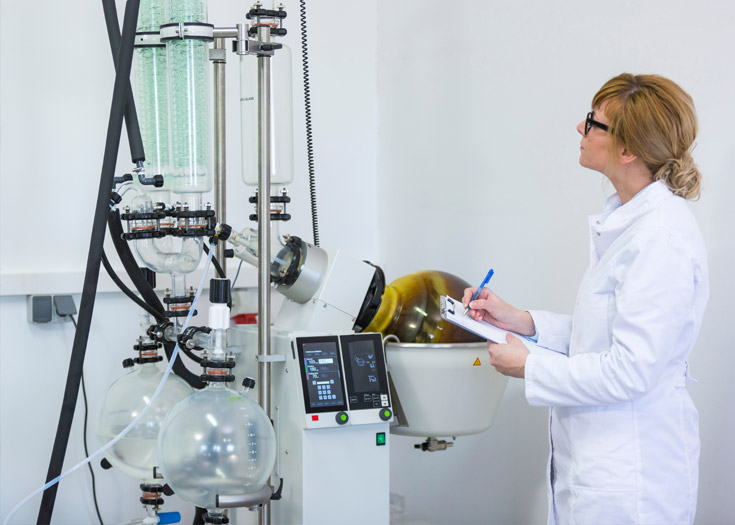
Essential Oil Introduction
With a growing number of states legalizing cannabis for medicinal and recreational uses, demand for high-purity products is on the rise. Extracting valuable oils from a plant, then refining and blending them in such a way to produce desirable medicinal effects has led to the formation of various markets with global reach. For example, people who suffer from anxiety or sleep deprivation can use CBD-dominant oils to calm themselves or aid in sound sleep. Others who require mild to moderate pain management can use THC-dominant oils to target pain receptors and ease the sensations they are experiencing. This market is so diverse that even edibles for the pet market are available to keep anxious dogs and cats calm. So how does the oil get from the plant to the consumer?
Efficient Extraction Processes Lead to a Better, Heathier Conusmer Product
There are many ways to extract essential oils and cannabinoids from a plant. Below, we will review some of the most common processes, like Short Path Distillation and Solvent extraction, that help extract valuable oils from the plant. A successful oil extraction process produces high-purity oils leaving no traces of process solvents in the final product. Although the science behind extraction can be quite complex, using vacuum during the process helps produce higher-purity products. We will review different types of distillation and extraction that produce high-purity essential oils.
Short Path Distillation Using Vacuum
Short Path Distillation is the most common extraction method that uses thermal separation to distill the oils. This technique uses a vacuum pump to promote the separation of valuable and 'useable' products from various contaminants that could influence the quality of the final product. Any remaining traces of undesirable contaminants will negatively affect the end product quality. Any liquids or vapors escaping the distillation column will enter the vacuum pump and contaminate the vacuum pump oil. In time, this contamination will negatively affect pumping performance and can cause vacuum pump failure in extreme cases. In some cases, oils and vapors that are sucked into the vacuum pump will exhaust into the atmosphere and can adversely affect the people using the equipment.
Ethanol Extraction Using Vacuum
Ethanol extraction is also another popular method of separation. Ethanol is used to strip the bulk product to separate 'usable' product from contaminants and other materials. In general, Ethanol can be very toxic to a person, so it is important that after the product has been fully processed and extracted, all the Ethanol is recovered. Vacuum is introduced to start this process, and the Ethanol needs to be recovered so that it is not ingested into the vacuum system or discharged to the environment.
Winterization Using Vacuum
Winterization is necessary to separate CBD from THC. To achieve winterization, the extracted product undergoes a thermal cycle to achieve further separation. Applying vacuum can speed up this process and facilitate more precise temperature control. The goal during winterization, and the other extraction processes mentioned above, is to separate the useable oil from the undesirable oils and contamination. It is critical to protect the vacuum system and equipment from harmful contaminants like pieces of the plant or toxic terpenes.
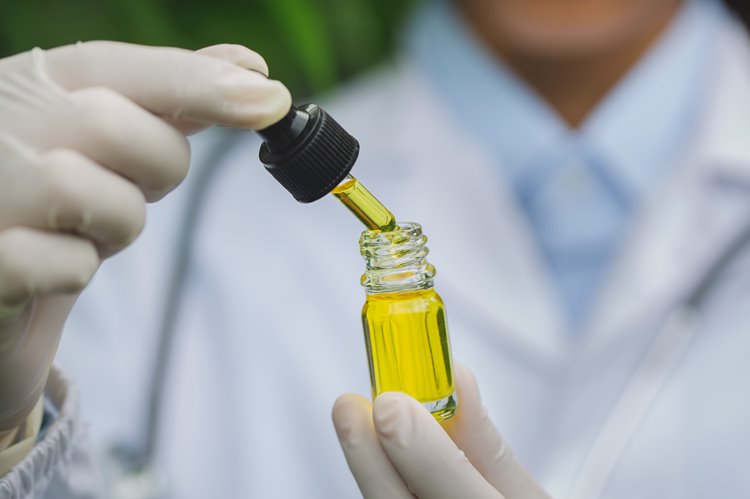
Vacuum ovens are commonly used to dry cannabis extracts, and the introduction of a vacuum helps facilitate a lower boiling point for the liquids. A lower boiling point will help extract solvents like Ethanol or even Butane as they evaporate and leave behind a purified oil extract. This technique reduces the danger of fire or explosion when using volatile solvents. When used at the end of the extraction process, a resilient vacuum system will allow extracts to be pure and free of solvents, BUT the solvents must go somewhere. So how do we capture them?
Protecting Your Vacuum Pump from Ingesting Solvents Can Be Challenging
Understanding basic vacuum principles is critical to the extraction process. Complexity increases when the system is under vacuum, and the solvents try to escape the chamber or oven. Because the vacuum pump pulls the solvents downstream towards the pump inlet, the solvents must be stopped.
A simple LN2, or liquid nitrogen trap like the Solberg LNT Trap, will freeze the solvents before they can carry over to the pump. These traps are constructed in either 304 or 316SS, which makes them resilient against many different solvents. This trap style requires some maintenance as the trap needs to evacuate the liquid nitrogen to atmosphere and requires a defrost cycle to recover the solvents. This trapping technology offers a high level of protection and keeps the vacuum pump from ingesting harmful contaminants.
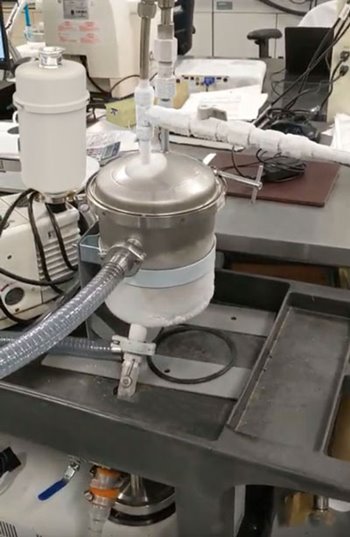
Other unique ways to protect vacuum pumps include chemical adsorption technologies like the Solberg VTL/VTS, or WL outfitted with an activated carbon element. Like the LN2, the chemical adsorption trap is constructed out of stainless steel but configured with a chemical adsorption filter element to help capture the solvents before they can make it to the vacuum pump. This technology will cost a little more to maintain, but overall maintenance costs for the system will be significantly less.
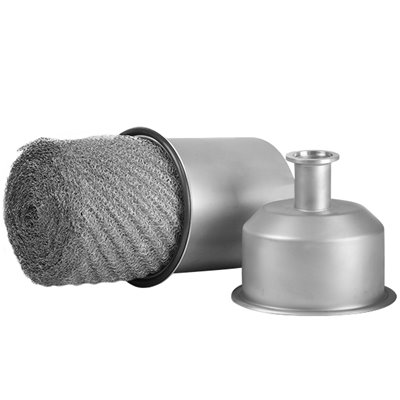
Protect your Equipment to Help Eliminate Downtime
Extraction equipment is a significant investment. The goal of essential oil producers is to extract the highest quality products at the lowest operating costs. Protecting your vacuum system is a great way to ensure minimal downtime and, more importantly, avoid costly vacuum pump rebuilds. To protect your vacuum pump, consider the challenge and what contamination you need to keep out of the pump. Most vacuum pumps fail because they ingest a harmful amount of particulate, liquid, or vapor (or all of these at once). When particulates like stems, sticks, or leaves are present, a simple yet effective vacuum inlet trap like a Solberg ST or CSL can be installed at the vacuum pump to stop particulates down to .3 micron.
More challenging to capture and significantly more harmful to a vacuum pump is liquid. A vacuum pump can ingest minimal amounts of liquid before problems occur. Excessive liquid carry-over can cause oil degradation and significantly impact vacuum pump performance. If large slugs of liquid carry over to the pump, components can break, and premature failure can occur. When installed near the process, a multi-stage liquid separator like a Solberg LRS is designed to "knock out" harmful liquids by separating the liquid from the air stream, resulting in clean, dry air.
The most challenging of all the contaminants is vapor. Vapor, unlike liquid, is significantly more challenging to capture due to how it transforms under vacuum. The easiest and most effective way to capture vapor before it can affect the vacuum system is by using a Liquid Nitrogen Trap like a Solberg LNT Trap or a Vapor condenser like a Solberg JST between the process and vacuum pump. When used correctly, an LN2 trap or a vapor condenser will stop solvent vapor before it can harm the vacuum pump. Adsorption technology can be used if LN2 or a coolant is not readily available. When vapor is present, using a vacuum inlet trap outfitted with a Solberg adsorptive filter element can help adsorb Methanol, Ethanol, Butane, Alcohol, and other harmful solvents.
Protecting Your Environment (and Laboratories)
Essential Oil Extraction has many benefits for the consumer, but there can be severe environmental implications during the extraction process. Vacuum pump inlet protection will minimize the impact on the equipment, but what can we do to protect the environment? Different pump technologies will pose different challenges, but let's start with the basics. Oil-lubricated vacuum pumps are commonly used in the extraction market. This vacuum pump technology generates an oil mist out of the discharge of the vacuum pump's exhaust. It can quickly coat an entire lab with oil mist in a matter of minutes, and the distinct odor can be unpleasant. A 2-Stage oil mist eliminator like Solberg's DSV Series will remove oil mist and uses an activated carbon adsorption polishing filter to minimize odors from discharging to the environment. This combination of oil mist removal and odor absorption will eliminate 99.97% of contamination from entering the atmosphere. In applications where dry scroll vacuum pumps are used, an exhaust silencer like Solberg's EFS Exhaust Silencer will help reduce noise in the laboratory, creating a pleasant work environment.
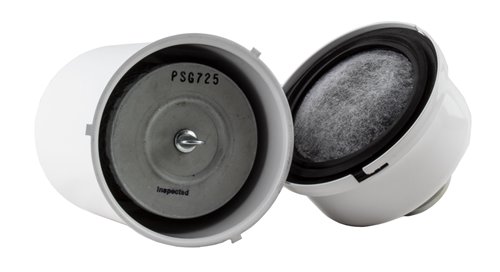
Conclusion: Putting the Whole Package Together So It Works!
Now that we understand extraction processes and the role vacuum plays in it, let’s review the best practices.
Early in the design process, it's important to consider the required vacuum level and pumping speed to achieve the parameters and outcomes in the process. Once the vacuum pump has been selected, inlet vacuum trap technology must be evaluated. Are you looking for a straightforward, set-it-and-forget-it approach? Or is the end user set up to maintain a more efficient filtration system like an LN2 Trap, which offers the highest purity products? A robust vacuum trap will help minimize downtime and improve the overall health of the vacuum system.
Vacuum pumps also need discharge filtration and silencing. For oil-sealed vacuum pump technologies, oil mist eliminators and adsorption filters keep oil mist, offensive odors, and harmful solvents from being released into the work environment. Dry vacuum pump technologies can benefit from discharge silencer filters and odor-removal products.
Solberg is proud to offer top-quality products, including industrial vacuum filters, traps, filter silencers, and oil mist eliminators for all types of vacuum pump applications. Our goal is to provide the market with filtration solutions that support a safe, clean, and efficient workplace.
For more information or to learn how we can help, contact us.